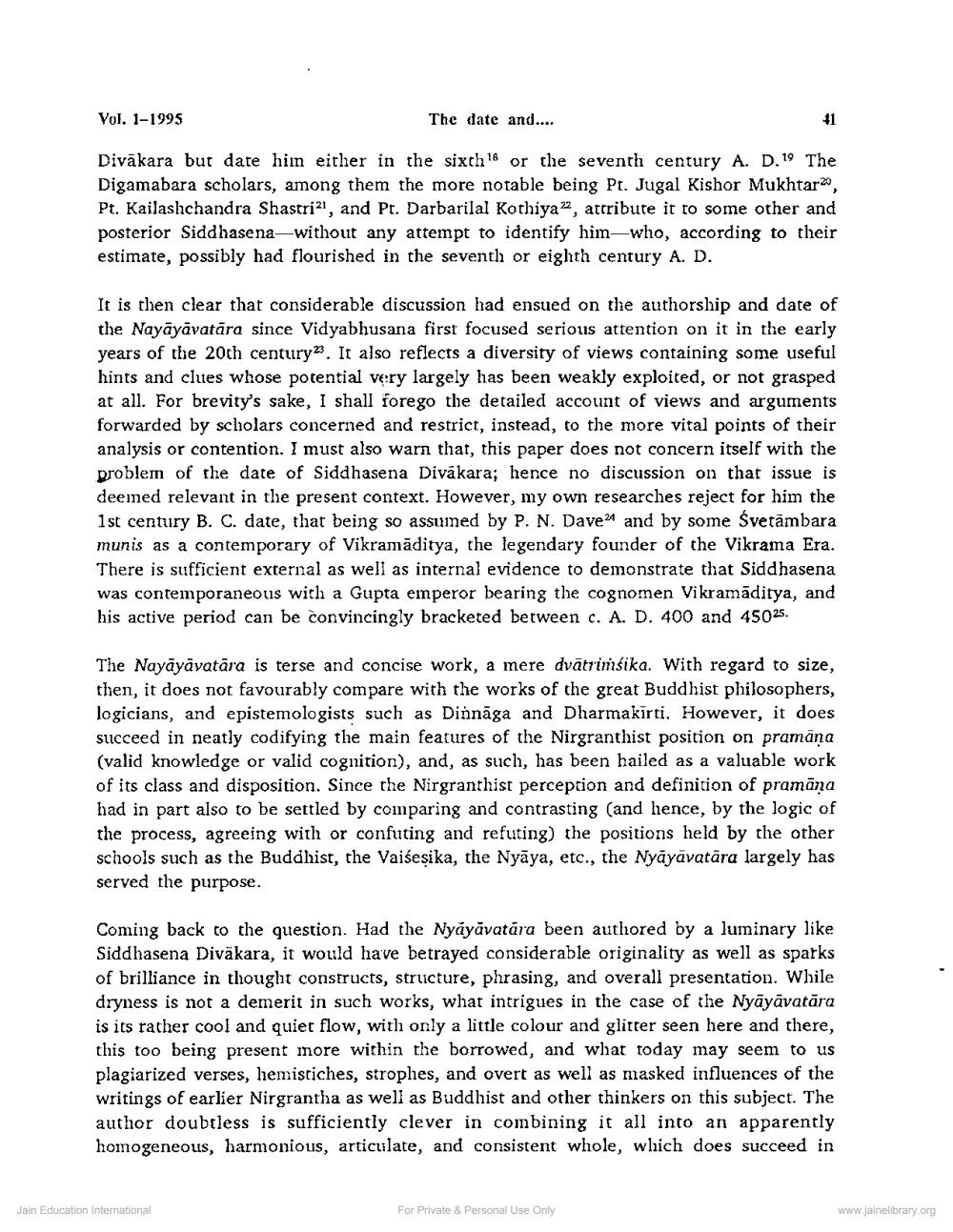________________
Vol. 1-1995
The date and....
Diväkara but date him either in the sixth or the seventh century A. D.19 The Digamabara scholars, among them the more notable being Pt. Jugal Kishor Mukhtar, Pt. Kailashchandra Shastri, and Pt. Darbarilal Kothiya", attribute it to some other and posterior Siddhasena-without any attempt to identify him-who, according to their estimate, possibly had flourished in the seventh or eighth century A. D.
41
It is then clear that considerable discussion had ensued on the authorship and date of the Nayāyāvatāra since Vidyabhusana first focused serious attention on it in the early years of the 20th century. It also reflects a diversity of views containing some useful hints and clues whose potential very largely has been weakly exploited, or not grasped at all. For brevity's sake, I shall forego the detailed account of views and arguments forwarded by scholars concerned and restrict, instead, to the more vital points of their analysis or contention. I must also warn that, this paper does not concern itself with the problem of the date of Siddhasena Diväkara; hence no discussion on that issue is deemed relevant in the present context. However, my own researches reject for him the 1st century B. C. date, that being so assumed by P. N. Dave and by some Svetämbara. munis as a contemporary of Vikramaditya, the legendary founder of the Vikrama Era. There is sufficient external as well as internal evidence to demonstrate that Siddhasena was contemporaneous with a Gupta emperor bearing the cognomen Vikramaditya, and his active period can be convincingly bracketed between c. A. D. 400 and 45025.
The Nayāyāvatāra is terse and concise work, a mere dvātrimśika. With regard to size, then, it does not favourably compare with the works of the great Buddhist philosophers, logicians, and epistemologists such as Dinnäga and Dharmakirti. However, it does succeed in neatly codifying the main features of the Nirgranthist position on pramāņa (valid knowledge or valid cognition), and, as such, has been hailed as a valuable work of its class and disposition. Since the Nirgranthist perception and definition of pramāņa had in part also to be settled by comparing and contrasting (and hence, by the logic of the process, agreeing with or confuting and refuting) the positions held by the other schools such as the Buddhist, the Vaiseṣika, the Nyaya, etc., the Nyāyāvatāra largely has served the purpose.
Jain Education International
Coming back to the question. Had the Nyayavatara been authored by a luminary like Siddhasena Diväkara, it would have betrayed considerable originality as well as sparks of brilliance in thought constructs, structure, phrasing, and overall presentation. While dryness is not a demerit in such works, what intrigues in the case of the Nyāyāvatāra is its rather cool and quiet flow, with only a little colour and glitter seen here and there, this too being present more within the borrowed, and what today may seem to us plagiarized verses, hemistiches, strophes, and overt as well as masked influences of the writings of earlier Nirgrantha as well as Buddhist and other thinkers on this subject. The author doubtless is sufficiently clever in combining it all into an apparently homogeneous, harmonious, articulate, and consistent whole, which does succeed in
For Private & Personal Use Only
www.jainelibrary.org




